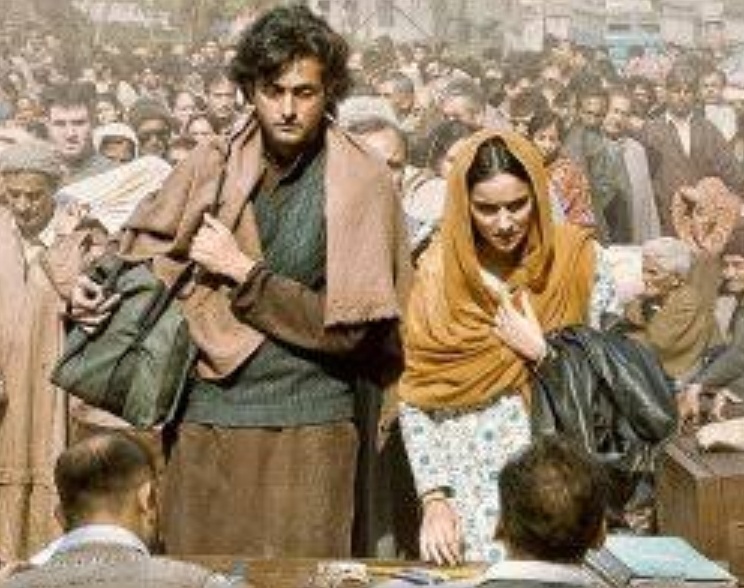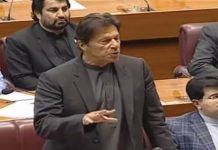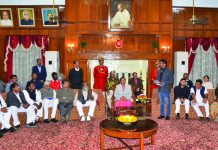 A special screening of Shikara, a film on Kashmiri pandits, held in New Delhi to mark 30 years of their exodus from the valley. The film narrates their agonising story by showing hundreds of families living in camps which were bereft of even basic facilities like toilets. Sometimes, a family of ten members were sharing a single tent where privacy was almost non-existent.
A special screening of Shikara, a film on Kashmiri pandits, held in New Delhi to mark 30 years of their exodus from the valley. The film narrates their agonising story by showing hundreds of families living in camps which were bereft of even basic facilities like toilets. Sometimes, a family of ten members were sharing a single tent where privacy was almost non-existent.
Shikara – The untold story of Kashmiri Pandits, directed by Vidhu Vinod Chopra and starred by newcomer Sadia as Shanti Dhar narrates how the plight of Pandits also failed to reverberate within the hallowed portals of Parliament – though several governments came and went.
“The politicians won’t be able to realise what it feels like to leave one’s home overnight, they only indulge in dirty politics in our name,” actor Shanti Dhar says in a dialogue in the film.
So, why did the Pandits leave the valley en masse? Shanti is not the only Kashmiri Pandit who is unable to answer the question though she knows the answer, there are several others who become emotional on being asked the same question. The word Kashmir creates a ripple effect in the hearts of Kashmir Pandits who still continue to live as refugees in their own country even after 30 years of their exodus. The story of Shiv Kumar Dhar and Shanti Dhar is a vivid portrayal of how India failed to ensure the safe return of Kashmir Pandits to the Valley in the past three decades.
Shikara has portrayed that several Pandits died of the trauma and diseases caused due to unhygienic living conditions in the camps. The Kashmiri Pandits were left to die at refugee camps as neither the local administration nor the so-called secular politicians came forward to help them, the film shows.
“Why didn’t you just stay in the valley?” Shanti Dhar is taunted by an official in the film as she requests the officer to register her family members at a refugee camp in Jammu. The official’s question was like rubbing salt into her wounds but Shanti could faintly hear his voice as memories from the past flashed in her mind. With tears rolling down her cheeks, she replied that she too owned a beautiful house in Kashmir but time had snatched all her happiness.
Being a Kashmiri, I too felt humiliated over the forced evacuation of the Pandits from the Valley. Once, my father told me that we too had a Pandit family in the neighbourhood. His name was Lalla Bhat. In 1990, when insurgency reared its ugly head in Kashmir, terrorists had given Lalla Bhat and his family three options — 1) to embrace Islam or 2) get killed, or 3) leave the valley and save life. Though several Kashmir Pandits embarked on mass migration to Jammu fearing for their lives, Lalla’s family refused to leave but for the sake of his family, he asked my father to help them to travel to Jammu.
My father somehow managed to get the vehicle from his friend and helped them reach Jammu during a cold night. My father used to visit the Bhat family on several occasions and the family bond is still intact. But a question always haunts me — Who is responsible for the exodus of Kashmiri Pandits?
Hum Wapas Aayenge
“Hum Aayenge Watan Aapne Haji Sahab Aur Yehi Pe Dil Lagayenge”, says Shanti Dhar to a Kashmiri while visiting the Valley in Shikara, which is slated to be released on February 7. Director Vidhu Vinod Chopra said his mother Shanti Devi was the source of inspiration behind Shakira while thousands of Kashmiri Pandits motivated him to complete the movie. “It took me 11 years to complete the movie. I wouldn’t have made it without Kashmiri Pandits”. The Pandits have also donned the hat of acting in the film.
“I am thankful to the entire crew as without their hard work and dedication, the movie couldn’t have been completed. We should acknowledge that Pandits were ruthlessly thrown out of Kashmir, and we should work for their safe return as no substantial help has been provided to Kashmiri Pandits for all these 30 years,” Chopra said
Pandit Voice
Author Rahul Pandita said they have survived as a community and tolerated the trauma. He also urged the Narendra Modi government at the Centre to work for their safe return to the Valley. “In the past 30 years, the previous governments remained silent which shows their failure over the issue. During 30 long years, we have survived as a community after going through so much trauma…”
“… Even after the abrogation of Article 370, our boys have lost jobs, said Babita Pandita.
“The hollow claims of Modi government have pushed us back. We can’t visit our relatives who have returned to the Valley as the government has abrogated the special status without consulting the regional population,” said a Kashmir Pandit.
“In the aftermath of the exodus, my father used to request us to take him to Kashmir as he wanted to live there”, said Sangeeta Mattu, daughter of Bansi Lal Mattu, who has played an important part in Shikara. Bansi Lal breathed his last recently.
Sangeeta was just 7 years old when the exodus took place. “Every time I watch the videos of the exodus, tears roll down my cheeks, which proves how much we miss Kashmir”, she said. Sangeeta’s sister Geetanjali still lives in Kashmir with her family.
On being questioned who is responsible for the exodus, Sangeeta said the people who wanted to help them could have helped but what they did was just politics over the issue.
Jagmohan’s doctrine
The book “Kashmir: Glimpses of history and the story of struggle” states that the former Governor of Jammu and Kashmir Jagmohan, who was appointed on January 19, 1990, is responsible for the exodus of Kashmiri Pandits. It’s alleged that Jagmohan encouraged the exodus for two reasons: First, Pandits would feel safe and secure in Jammu and further killings would be stopped. Second, he wanted to deal with the situation without harming the Hindu population. Many believe this approach backfired while the law and order situation in Kashmir further deteriorated from time to time. Just two days after his appointment, 50 persons were killed and 250 others sustained injuries after security forces opened indiscriminate firing on peaceful protesters in Srinagar’s Gawkadal area on January 21, 1990. Even after Jagmohan’s removal, law and order situation paved way for other lethal laws like the AFSPA which had to be imposed in the same year.
What Kashmiri Historian says
Basically the migration of Kashmiri Pandits to Jammu and other cities was a big blot on Indian democracy. The 1989 insurgency was the outcome of the 1987 Assembly elections when Muslim United Front (MUF) comprising of leaders like Mohammad Yousuf Shah and others accused that the polls were rigged, which is well acknowledged by historians and media organisations.
“Syed Salahuddin, chief of the militant outfit Hizb-ul-Mujahideen, was not only falsely implicated in the rigged elections, but also imprisoned, and his allies like Ashfaq Majid Wani, Javed Ahmed Mir and Mohammed Yasin Malik, who formed the Jammu Kashmir Liberation Front (JKLF) were also jailed by the Jammu and Kashmir administration”, said a Kashmiri Historian.
He also said the forcible eviction of Kashmiri Pandits was planned. “How could they arrange vehicles and help thousands of Pandits to evacuate their homes within such short span of time? The government could have chosen to provide them security and ask them to stay,” he added.
The worst rigging of 1987 elections gave birth to an armed struggle in Kashmir, which resulted in innumerable fake encounters, custodial deaths, rapes, torture, enforced disappearances, massacres and other worst episodes.













